These days, there are many ways of combating baldness, from the simplest to the most sophisticated, from the most original (to say the least) to the most professional.
It's not always easy to make sense of all these hair loss treatments.
That's why only one question matters: what will the best solution to combat the effects of baldness for me ? Do I need a topical treatment? Should I have a hair transplant? Should I do both?
At Centre Clauderer, we don't claim to offer a miracle solution that will make your hair grow back in just a few weeks. With over 50 years' experience, we offer effective, long-lasting treatment against baldness, treatment adapted to each case, once the hair diagnosis has been carried out.
Not only is a natural solution to baldness possible, it's also within reach: with hyper-concentrated formulas and no side effects, Clauderer's anti-hair loss protocols are quick and easy to follow. The aim: to slow the progression of baldness and stimulate healthier hair growth.
To give you a clearer idea of how a baldness treatment at Centre Clauderer works, here are 3 representative examples:
- 3 different routes
- 3 different degrees of baldness
- 3 different treatments
- 1 result : positive and lasting effects for everyone.
In this article, we focus on the treatment of baldness in men; see our article on the treatment of baldness in women here.
Here are three stories from three of our customers. Gabriel, Medhi and Antoine (their first names have been changed to respect their anonymity) are very different ages, but they have one thing in common: they all had symptoms of a hair loss in men and Clauderer provided them with a solution to combat their baldness. Satisfied with their experience, they gave Clauderer permission to tell the story of their "hair adventure".
GABRIEL - AGED 19 - EARLY ALOPECIA
GABRIEL'S HAIR
At the time of his first appointment, Gabriel had been losing over 100 hairs a day during his daily shampoo for 6 months. This hair loss is accompanied by severe seborrhoea and oily dandruff. Gabriel, haunted by his father's baldness and the fear of one day going bald, generates a great deal of stress. He finds it hard to concentrate on his lessons. He doesn't do sport any more, for fear of increasing his baldness. Despite his young age, he is already considering a hair transplant.
HIS SPECIALIST'S ANALYSIS
The traction test confirms that a lot of hair is falling out. Nearly half the hair is missing from the front. The scalp skin is supple, but easily irritated. Microscopic examination revealed an aggravating factor: anxiety (stress) linked to hair loss.
HIS TREATMENT
Intense, for 4 months and for three minutes every day, to treat the three vital functions of your hair, i.e. cleanse your scalp, neutralise hair loss and the negative effect of androgens on your hair roots. At the same time, general advice: get back into sport to reduce nervous tension, reduce your consumption of red meat and dairy products in favour of fish and white meat. Reduce sweets if possible. Clauderer products: Lait n°1R, Sérum 6R and 7R alternately and Emulsion N°17 to combat greasy hair.
EVOLUTION OBSERVED
After 3 weeks, the dandruff had disappeared and hair loss had already reduced significantly. After 4 months, hair loss had stabilised at around 15 hairs a day, and the expected regrowth had set in. To reinforce the results obtained, Gabriel continued the treatments at the same pace for a further 4 months to ensure that the hair was better anchored. Today, 4 years later, Gabriel continues to maintain his hair, but only twice a week, and only comes to the Centre twice a year for check-ups and to renew his programme. The new growth compensates well for the hair that has fallen out. If he remains vigilant and assiduous, he will avoid galloping baldness and will be able to keep most of his remaining hair without the need for a transplant.
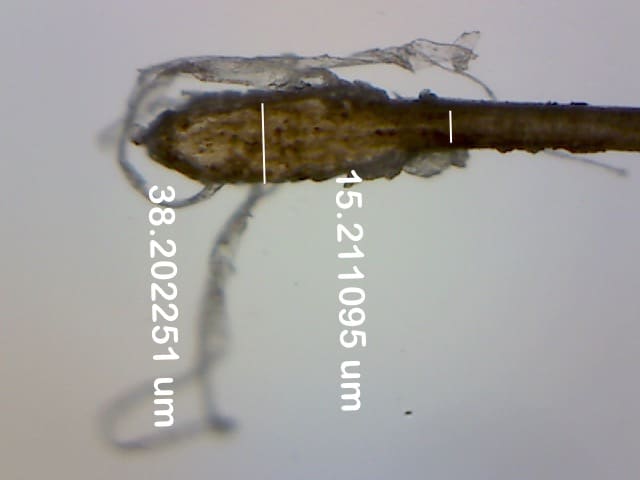
Gabriel: Root during diagnosis
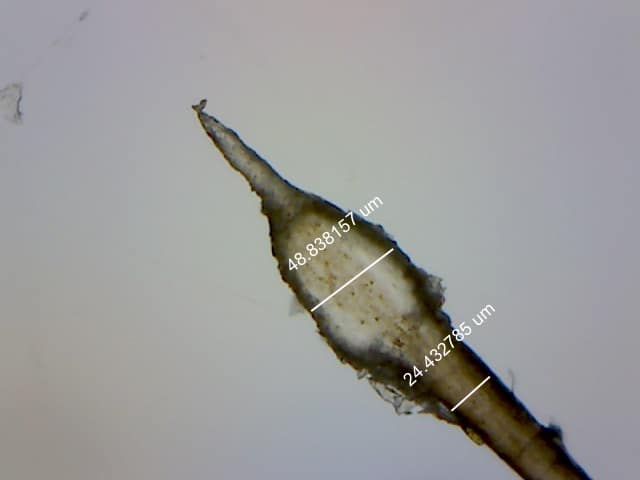
Gabriel: Root after 2 months
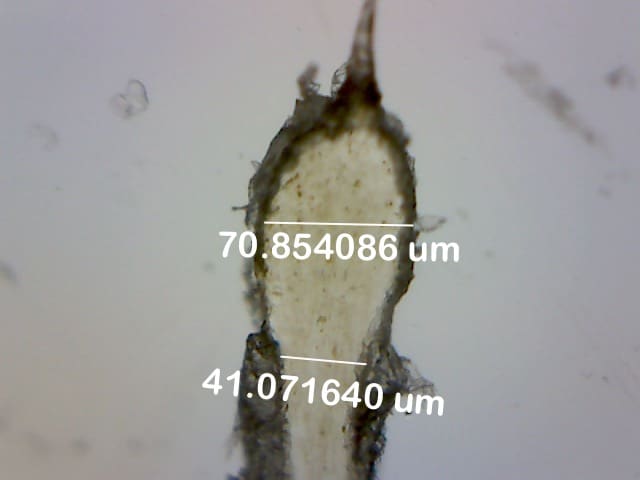
Gabriel: Root after 4 months
MEDHI - AGED 30 - INCIPIENT ALOPECIA
MEDHI'S HAIR
The hair is thinning, sparse on the vertex and the gulfs are slightly marked. His father and paternal grandfather kept their hair, but his maternal grandfather didn't have much left at 60. Over the last ten years or so, Medhi's hair has been slowly but surely receding. He admits that he has a complex about his hair and feels that everyone is noticing his incipient baldness. But he doesn't dare talk to anyone about it, and on the rare occasions when someone close to him has tried to broach the subject, he's always evaded the issue. Discreetly, almost in secret, he applied minoxidil for 8 months 2 years ago. Persistent scalp irritation forced him to stop the treatment.
HIS SPECIALIST'S ANALYSIS
During the traction test, the hairs collected are of very different sizes. Examination of the scalp and microscopic analysis confirm that the vital functions of hair are disrupted by the negative action of DHT (androgens): sebum is overstretched, its elimination is insufficient and circulation is deficient. The result is progressive atrophy of the roots in fragile areas.
HIS TREATMENT
As with any initial treatment, it will last 4 months, with an initial check-up after the first 2 months to observe the development of the hair follicles. The main aim is to rebalance the hair's vital functions and compensate for the negative action of androgens. Medhi's recommended protocol: applications of Lait N°3 and Serum N°7R, followed by Emulsion N°21 for his daily shampoo. Like many people, Mehdi was initially a little reluctant to take the plunge, but clinical tests proving that Serum 7R's anti-androgenic action was faster and more radical than that of minoxidil convinced him. What's more, this serum has no side-effects that bother the scalp and is not habit-forming.
EVOLUTION OBSERVED
Hair loss slowed down after three months. It practically disappeared in the weeks that followed. Around the fourth month, the new growth was more vigorous and began to restore volume to the hair. Medhi took charge at a time when it was still possible to act effectively, but he knows that the terrain is fragile and that he must remain attentive to his hair. The results he has achieved are not definitive, and regular maintenance treatments (Serum N°6R) are essential to maintain them and renew his new growth. The Clauderer solution suits him perfectly because he knows he can continue his programme for as long as he likes, without the risk of sudden hair loss if he stops his treatment (unlike minoxidil).
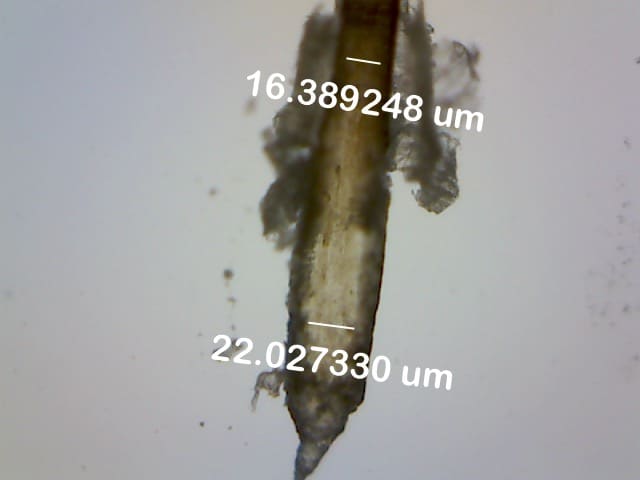
Mehdi: Root during diagnosis
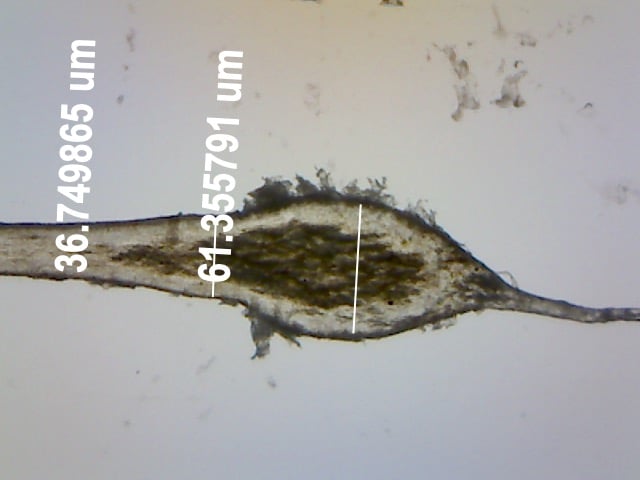
Mehdi: Root after 4 months
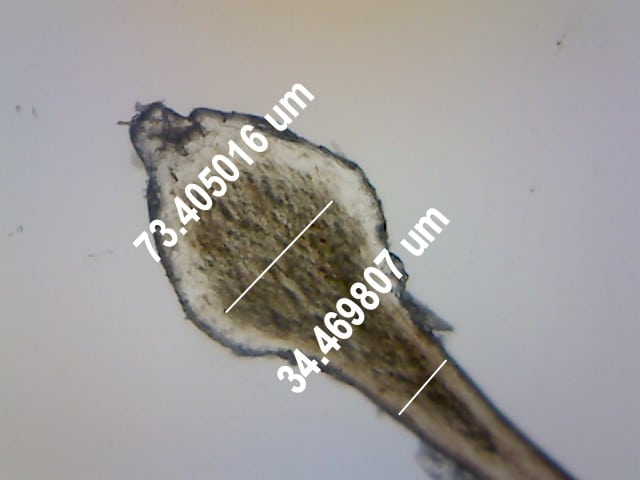
Mehdi: Root after 2 years
ANTOINE - AGED 52 - MODERATE ALOPECIA
ANTOINE'S HAIR
He never really saw them fall and never treated them either. Everything was very progressive, very diffuse, he can't remember any spectacular hair loss, even when he was younger. Today, however, the results are there: his hair has thinned and become slightly sparse on the top of his head, as well as on his vertex, where a small bald patch is beginning to appear. Now in his fifties, Antoine has decided to consult a dermatologist. Can anything still be done?
HIS SPECIALIST'S ANALYSIS
Yes, of course. We're not going to give him his teenage hair back, but he can easily keep the hair he still has on his head and improve its quality.
HIS TREATMENT
It is not very restrictive, but should be followed up regularly. The main aim is to relieve stiffness in the scalp, stimulate blood flow and provide local nutrients that the roots need to react. For Antoine, whose scalp is quite sensitive, Lait N°3R + Serum N°7R and Crème Lavante N°25 to nourish and strengthen his naturally fine, rather dry hair. We advise him to adopt a few healthy lifestyle habits: cut down on overly processed foods, and fill up on healthy fats, fruit and vegetables.
EVOLUTION OBSERVED
Alopecia stabilised in the first few months. Now, 2 years later, the baldness has stopped and his hair has grown stronger, even in the most fragile areas such as the vertex. Antoine has proved to be diligent and conscientious, and all the more motivated as he quickly noticed improvements. He visits Centre Clauderer twice a year for check-ups and to renew his products. He has become an "absolute fan" of Lait N°3R! He has two young sons, soon to be teenagers, and promises to keep an eye on their hair, "to give them every chance of success, right from the start".
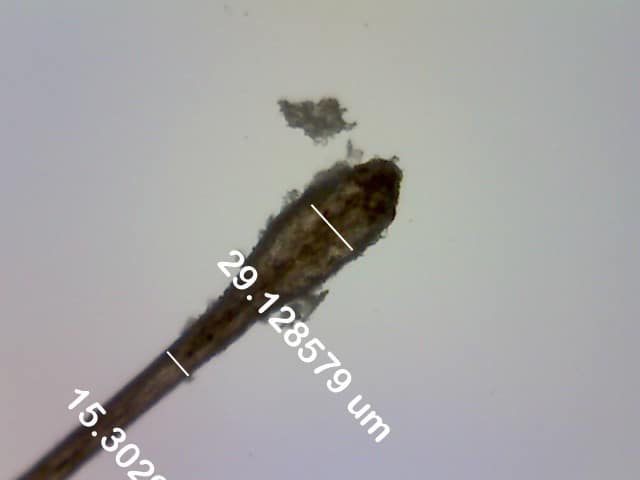
Antoine: Root during diagnosis
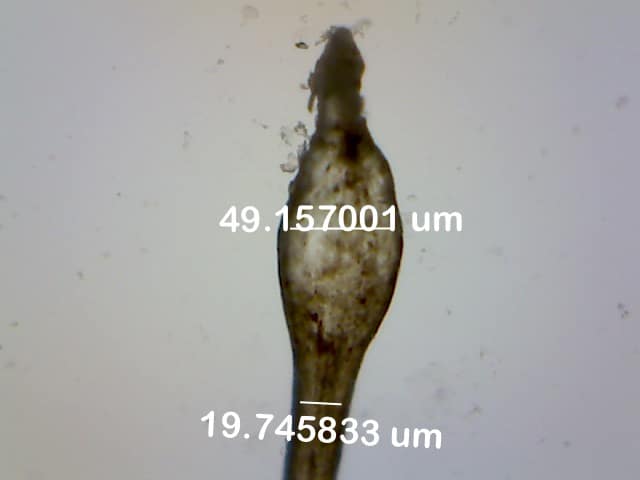
Antoine : Racine after 4 months
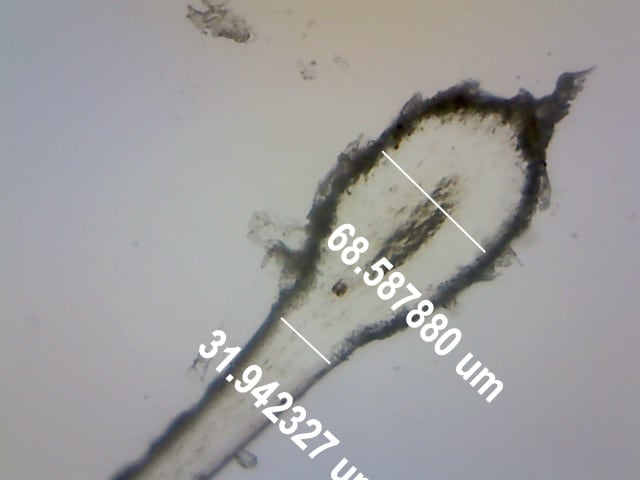
Antoine: Racine after 2 years
ANDROGENETIC ALOPECIA IN BRIEF
Androgenetic alopecia is the most common form of hair loss, affecting more than one adult male in two in Western countries. To varying degrees, of course. Some will be bald by the age of 30, others will be only slightly 'bald' by their 60s, depending on the severity of the aggravating factors and any treatments undertaken.
Symptoms. The severity of the symptoms depends largely on the age at which they appear. When hair loss is noticeable from the end of puberty (see Gabriel's case), it is almost certain that baldness will set in before the age of 30, if the person concerned does nothing to treat it. To find out where you stand, consult the Hamilton scale.
Location. Whether rapid or slow, the process of hair loss varies little from one man to another: it starts at the top (gulfs or forehead), reaches the vertex (tonsure) and the top of the head but preserves the nape of the neck. This description is schematic, of course, but you should find yourself in these standard stages of baldness around the lower part of the head.
Regrowth. The hair that falls out is replaced by hair that becomes thinner and shorter, until a fine, barely perceptible fuzz appears. Terminal phase, regrowth of the hair. This deterioration takes place over a variable period depending on the individual.
Origin of androgenetic alopecia in men. Produced by the testicles and adrenal glands, androgens are the hormones responsible for the hair disorders that characterise androgenetic alopecia. This disorder is of hereditary origin : at birth, newborn babies already carry the gene that is likely to cause them to develop baldness of varying degrees of severity later in life. The condition does not affect children, as androgen secretion only begins at puberty. It also spares eunuchs and castrated men, as this secretion is then artificially interrupted.
How does it work? Normally, testosterone circulating in the blood binds to a protein which neutralises it. Only a tiny fraction can escape this metabolism, remain biologically active and reach the hair follicles via the papilla. It is then transformed by a local enzyme (5a-reductase) into a new hormone (DHT), which is the real cause of baldness.
What exactly happens? The growth phase of healthy hair usually extends over a period of two to four years, depending on the man. Here, stimulated by the influential enzyme, DHT will relentlessly activate the hair's growth rate, shortening its life and precipitating it too quickly into the hair loss phase.
The result: a chain reaction... The diseased hair falls out before reaching its maximum length, giving way too quickly to new growth, which will itself have a shorter life. The papilla and cells of the hair follicle, which are constantly under pressure from this pathological acceleration, tend to atrophy. As their volume shrinks, they can no longer produce hair of normal diameter, which explains the fine fuzz mentioned above.
The role of sebum. Very often, the enzymatic action not only stimulates hair growth abnormally, but also acts as a catalyst for the activity of the sebaceous gland, accelerating the progressive shrinkage of hair cells.
Here again, there is a chain reaction: too much sebum secretion stagnates in the hair follicle, thickening the scalp and preventing the blood vessels from carrying out the exchanges with the root that are necessary for hair renewal. What's more, sebaceous secretion contains fatty acids that irritate the skin and can cause dandruff.
What is still poorly explained
- Why is it that premature hair loss always spares the lower part of the head, leaving a crown of hair around the head, even in very severely bald people?
- Why is it that the androgens that transform facial hair into beard from puberty onwards can have the opposite effect on some scalps, transforming hair into down?
READ ALSO
Men's hair loss
Treatments for hair loss
What can serums 6R and 7R do for me?

